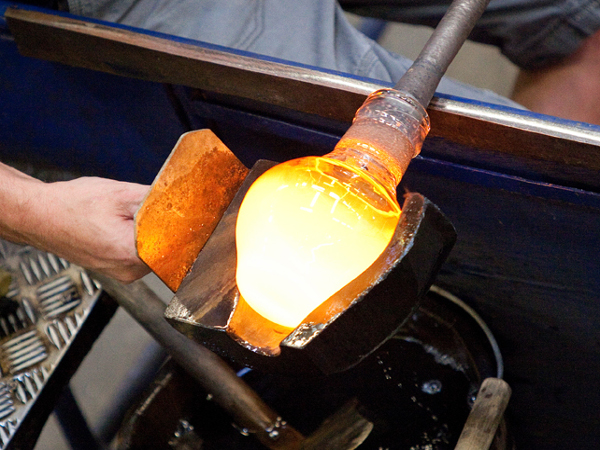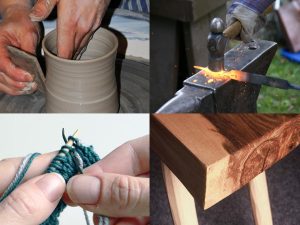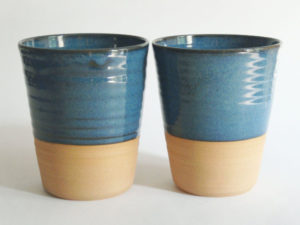Glassblowing - introduction

“Glassblowing is an animal unto itself. It requires skill, knowledge, physical strength and respect.” – William Morris
Contents
What is glassblowing?
Glassblowing is the art of shaping molten glass by blowing air into it through a long metal tube.
Glass is composed of a variety of materials. The most common types used today are lead crystal and soda lime glass. Lead crystal (most commonly used for blowing) is made from a mix of silica sand, 24% lead oxide, small amounts of chemicals like potash, and cullet (crushed waste glass). Soda lime glass is made from sand and soda lime and is the most common kind of household glassware found today. In its molten state glass is extremely malleable; when cool it’s very hard and brittle, but also very hardwearing and has been used to make practical and decorative items since ancient times. Technological advances and innovations over the centuries have seen it incorporated into a diverse range of fields, from architecture to telescopes to telecommunications and more.

History
The first glass used by humans was obsidian, a black glass forged in the fires of volcanoes and used by Stone Age peoples to make rudimentary tools. The origins of manufactured glass remain obscure but it’s thought to date back to Mesopotamia, around 6000 years ago. The earliest known examples of glass objects are beads, pottery glazes and later, hollow vessels made by shaping molten glass around a compacted sand core. The development of glassblowing, somewhere between 100 BCE and 100 CE in what is now Syria enabled large-scale production and a greater variety of shapes. Apart from the means of heating the glass (nowadays with gas furnaces), the basic tools and techniques have remained largely unchanged to the present day.

The Romans adopted and further developed glassblowing, disseminating it throughout their Empire and to Britain. In the Middle Ages, Bohemia (in what is now the Czech Republic), and later Venice, became centres of glassmaking excellence, refining it to a high art and jealously guarding trade secrets. All of these cultures experimented with composition of base materials, production methods and use of colour, improving the quality, clarity, purity and range of uses. One such innovation was the perfection of lead crystal by the Englishman George Ravenscroft in the 17th century. Ravenscroft achieved a superior, high-lead-content mixture perfectly suited to the deep cutting and engraving fashionable at the time.

Although other methods, such as flat or ‘plate’ glass for windows etc., were developed over the years, blown glass remained the main means of production for nearly 2000 years until the advent of machine production in the 19th century. Today, industrial-scale glassblowing is much less widespread than it once was but the craft is kept alive and well by a few surviving high-end companies and smaller artisan producers and teachers.
Video showing the basics for blowing a glass jug in a mould.
What are the benefits of glassblowing?
- Glassblowing is a useful skill that can be turned into a career, supplying a range of decorative or practical items – from wine glasses to decanters, jugs, door knobs, lamps, sculpture and chandeliers – to the local community.
- It’s an addictive, fascinating and magical art that has been likened to alchemy. It’s fast and exhilarating to watch or learn and it’s very satisfying to be able to make something with your own hands (and lungs).
- While expert glassblowers are capable of making large runs of identical items, it’s often the imperfections and individuality of hand-blown glass that makes it attractive, standing out from the ranks of ubiquitous items churned out by large corporations.

- Though lead crystal – the material of choice for blowing – can be more expensive than other types of glass, its enhanced brilliance, softness, clarity and ring make it a superior product.
- While it’s more expensive to buy hand-blown glass from a local artisan producer, more money in their pockets means more money in the local community, which is good for everyone.
- A certain amount of waste cullet gets ploughed back into making other items by the larger industry producers, reducing raw material use and energy costs to a degree. The rest of the cullet is sold on to smaller artisan producers who use it as their base material. So there’s some ‘recycling’ involved.
- It is also possible to melt down and recycle old glass containers. However, the absence of lead in container glass means it cools quicker and is therefore much harder to work. It also tends to be greenish and difficult to colour, meaning it has a more limited range of applications than new material. Lead crystal can be melted down and reused although there doesn’t tend to be much of a market for it.

Glassblowing does have some drawbacks:
- It’s not a skill you can pick up quickly.
- You need a specially-equipped space to do it and there are some significant setup costs involved.
- Energy use is a significant issue in glass production. While some small producers are experimenting with renewable energy sources, most furnaces are still powered with gas, a fossil fuel associated with carbon emissions, and a finite resource. It takes two days for a furnace to reach the required working temperature of over 1000°C, meaning that it has to be kept going even when not in use, i.e. overnight, so as not to slow production.
- Raw materials are extracted through mining, which has a high environmental impact. Raw materials also have to be shipped to the place of production (although given the weight involved, these shipping distances are kept to a minimum wherever possible).
- Lead glass also has an impact in terms of leaching into ground and air; and there are particle emissions from furnace exhausts. However, large industry producers are subject to strict controls in these areas.
And this is what you can do if you get really good. Shows a decanter being made by being blown into a mould, then shaped with a paddle.
While the high working temperatures mean that glass is more energy-hungry than some other materials, like ceramics, it does have the advantage that, in theory at least, it’s infinitely recyclable. By contrast, the potential for recycling ceramics is much more limited (it can’t be re-fired and made into other things so it tends only to be crushed up for use in industrial production). Recycling glass has the potential to save on raw materials extraction, energy costs and waste disposal, although in practice it’s not being recycled nearly as much as it could be and we’re nowhere near the ideal of ‘closed loop’ production.

What can I do?
You can start by supporting your local glassblower, if you have one. If you’re interested in taking it further and training as a professional, the first step is to take a class or course to see whether you’ve got the required manual dexterity and hand-to-eye coordination. Every incipient glassblower needs a lot of help and practice in the beginning and there’s a lot to learn. Glassblowing isn’t for everyone: it can be scary (fear of fire and extremely hot objects is pretty innate) but it’s surprisingly safe when working in a controlled and supervised environment. A starter course will cost anywhere upwards of £100 per person per day.

Clear glass cullet is melted in a pot in the furnace at around 1100°C, and a blob wound onto the end of the blowing iron, known as a ‘gather’. This is then rolled and rounded (or ‘marvered’) on an iron slab, at which point it’s known as a ‘parison’. The glassblower then controls, blows and shapes the parison using the blowing iron, a variety of tools and gravity to shape it during the short window while it cools and thickens to around 900°C. The glass is then returned to the furnace to reheat and the whole process is repeated until the finished object is obtained. The partially shaped object may also be placed inside a mould and blown to fit the shape. Colour can be added if required by introducing coloured rods during the melting process (larger producers also add pigments directly to the glass mix).

To be a successful glassblower you need to be able to use the tools as an extension of your own hands since – unlike pottery – you can’t touch the incredibly hot thing you’re working on. The best glassblowers are very light-handed and use heat and gravity to do most of the work for them. You need to be very methodical, able to visualise the finished product before you start and capable of doing different things with each of your hands at the same time. To make a career of it you need to be prepared to work very hard with very little success for several years while you slowly learn and improve. The usual route is to study it at art college or similar and go on to an apprenticeship or employment with a large company before going it alone.

To set up a working studio you’re looking at an outlay of several thousand pounds, so you either need substantial savings or to get hold of a very generous grant. Day-to-day running costs are also high: think upwards of £2000 per month on gas and electricity alone. Unless you have money to burn, before taking the plunge you need to be sure of your market and that you can cover your costs. It also doesn’t hurt to have a back-up plan or some savings to see you through the lean times every small producer experiences. Working in a co-operative and sharing a furnace in shifts may be one way to maximise use of fuel and share costs.



5 Comments
Very interesting, but I don’t see how what is shown here can be considered ‘low impact’, or any way I could do this at home without thosspecialist gas-guzzling burners.
-Any chance of an article showing how this could be done using a forge-type charcoal hearth?
You’re right – this is a recurring problem in trying to make activities more sustainable. You’d have to question whether some activities can ever be sustainable. Electric vehicles is a good example. In a world with a human population headed towards 10 billion, can we all have a car – electric or not? We have to draw the line somewhere – and it’s difficult. There won’t be any articles about how you can reduce the impact of air travel, for example. It’s just too damaging for us to support.
But glass – can we have glass products sustainably? I don’t know, but yes, we’ll certainly be trying to get an article on using charcoal etc. for the furnaces. After all, glassblowing existed a long time before we had gas furnaces.
There’s another aspect of ‘low-impact’ that we promote though, and that’s ‘conviviality’ – it’s a term coined by Ivan Illich, and it means that an activity can be organised at the individual / community level. So goods and services can either be provided by large corporations, or by small companies / co-ops / self-employed people. We prefer the latter. We’d like to see the entire economy organised this way. At the moment, the corporate sector is taking over all aspects of the economy, concentrating wealth which floods into the political system, making it more difficult to get away from the hierarchical, growth-obsessed, ruthless model that is so damaging.
But it would be great if furnaces could be powered from renewables – same for blacksmithing and pottery.
I would like to know who wrote this even if they aren’t lowimpact.org’s.
HI Anisha, the information is at the bottom of the article: Thanks to Emsie Sharp of Emsie Sharp Glass and Richard Halliday from Dartington Crystal for information